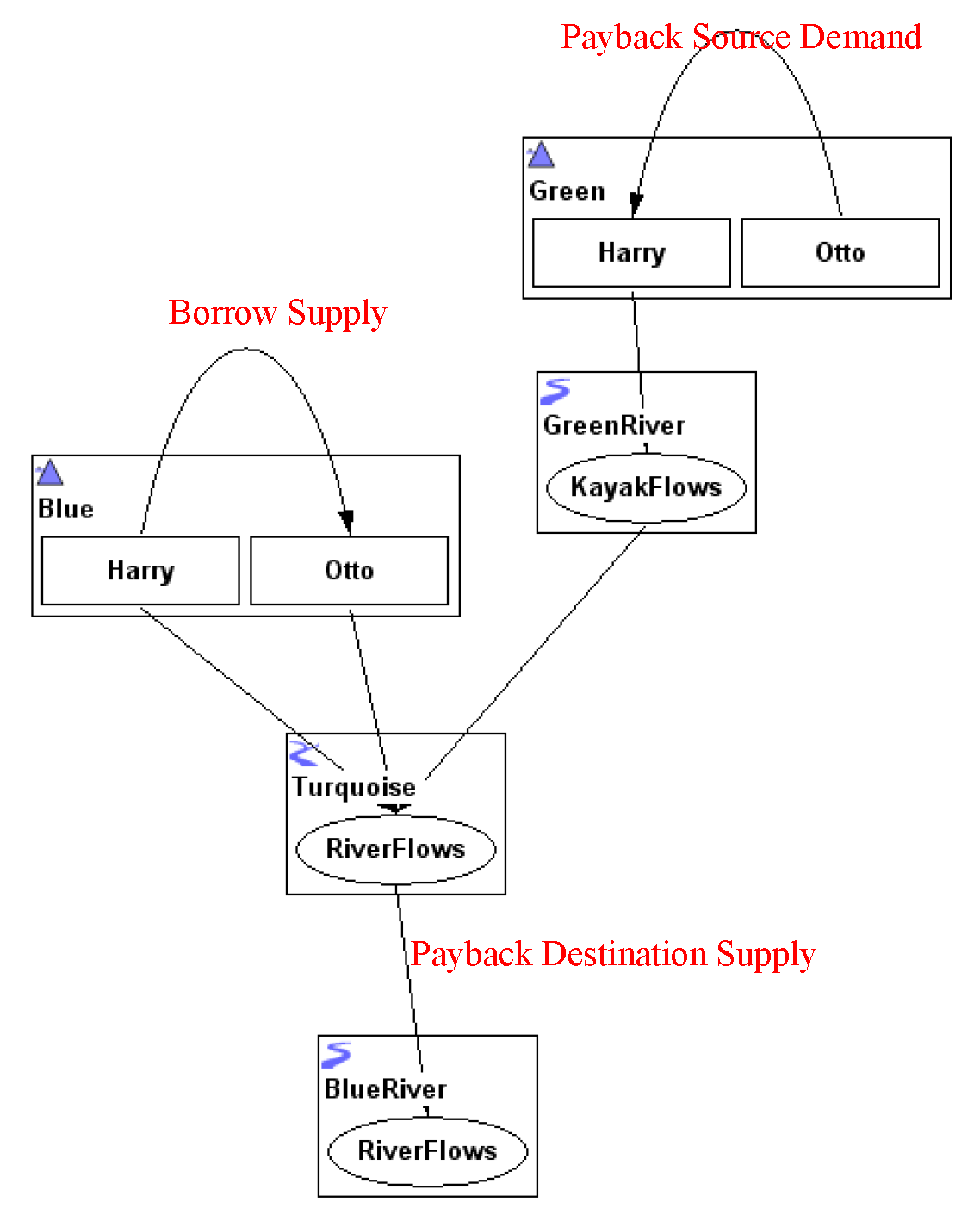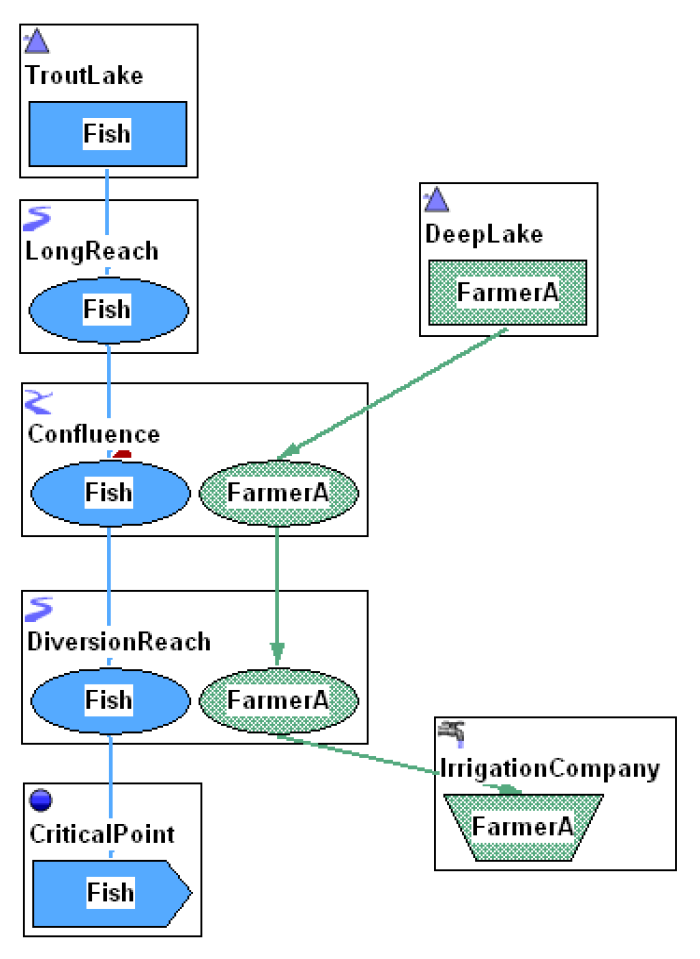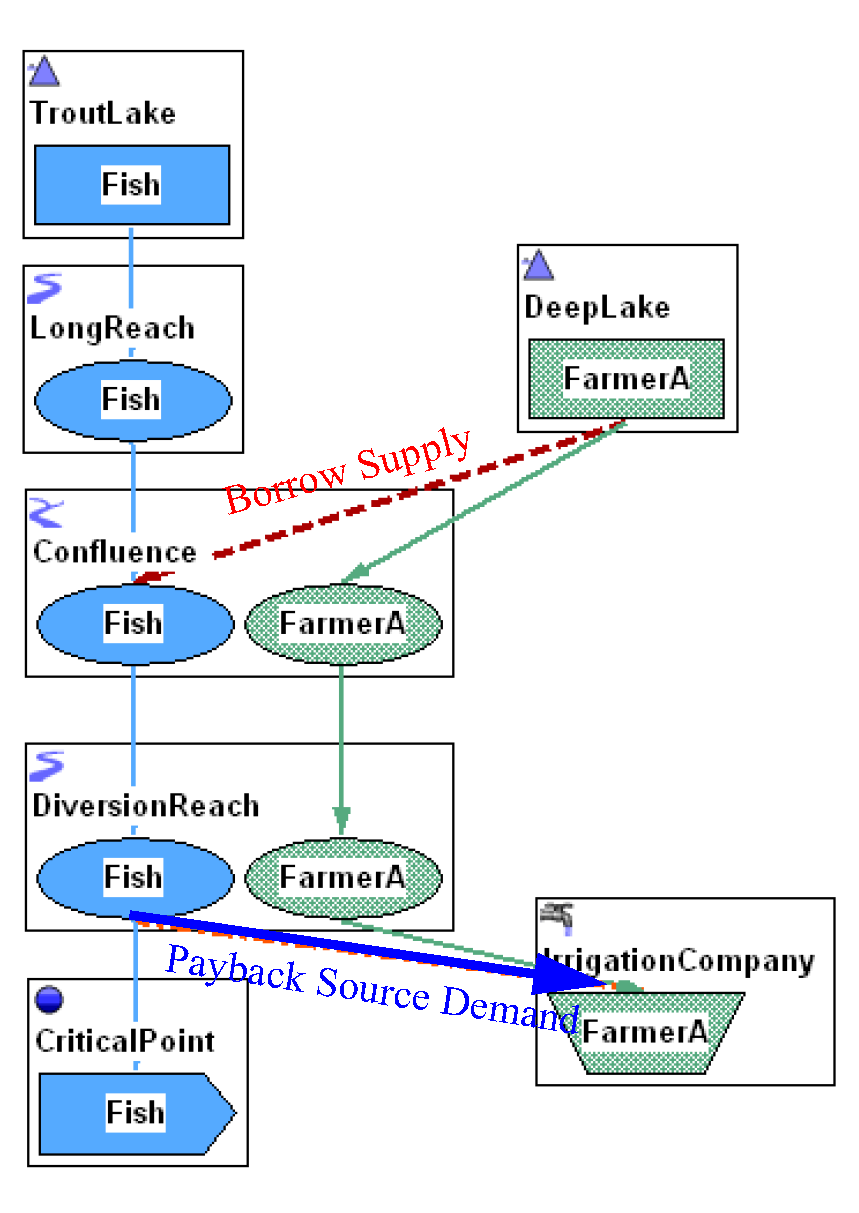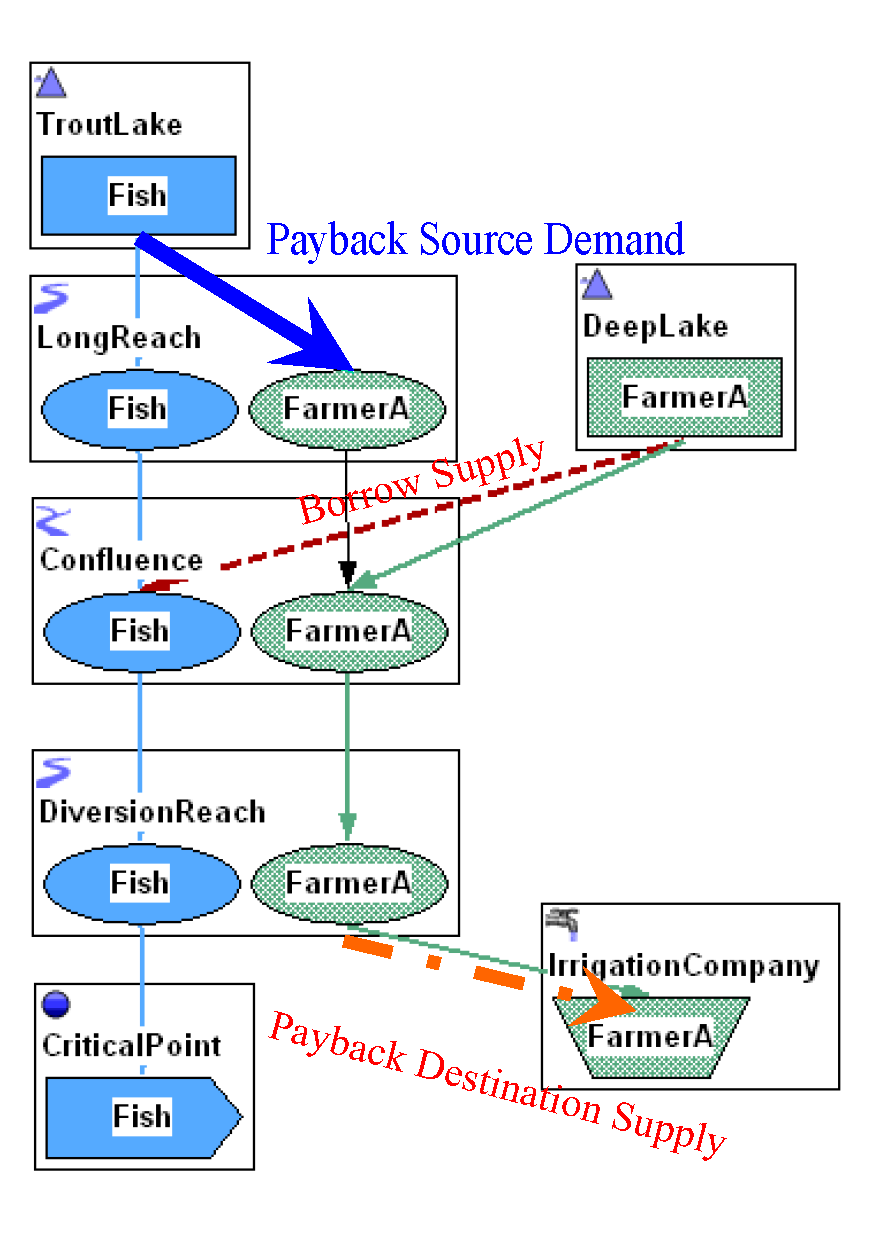Exchange Examples
Example 5.1 and Example 5.2 illustrate exchanges and how they are defined in RiverWare.
Example 5.1 is a simple problem but explores the configuration of the supplies. Example 5.2 is more realistic and presents alternative configurations for the exchange.
Two water owners, Harry and Otto own water in two different reservoirs, Green Lake and Blue Lake. On each of the reservoirs are accounts Harry and Otto. At Blue lake, Otto owns a dock for fishing and wants to keep the reservoir as high as possible during the summer. As a result, he has agreed to borrow water from Harry during the summer for fishing. He will pay back any water borrowed by transferring water at Green lake from Otto to Harry. Harry loves this idea because he is an expert kayaker and now controls more water in Green Lake which he can release directly into his favorite kayaking reach, GreenRiver. Let’s set up this exchange: We establish a supply transferring from Blue^Harry to Blue^Otto to represent Otto borrowing water from Harry at Blue Lake. This supply will be called Borrow. Otto returns water to Harry at Green Lake; this is represented by a supply called Payback, which will be a transfer from Green^Otto to Green^Harry. All the water that flows through Borrow at time t increases Otto’s debt at time t, and all that flowing through Payback decreases the debt at time t. In the exchange manager, Borrow is the Borrow Supply and Payback is the one and only Payback Source Demand. Returning to the example above, Otto decides that Kayaking isn’t for him but instead wants to innertube on the calm BlueRiver downstream of both reservoirs. We still want to keep track of the debt at Blue Lake, but perhaps he does not want the debt to be considered repaid until the water reaches the Blue River downstream of both lakes. To model this, we choose “Turquoise RiverFlows to BlueRiver RiverFlows” as the Payback Destination Supply. Water flowing through this supply represents the total water paid back, and the balance at time t is maintained in the exchange slot Destination Balance. In this way, we see that any water released out of either Blue or Green would repay the exchange. Figure 5.1 shows the layout of this accounting system and the appropriate supplies. |
Figure 5.1

In this example, we first describe the physical conditions, background, and policy that motivate this exchange. Then we describe how to define this exchange in RiverWare. The following diagram shows a layout of a basin consisting of two reservoirs. TroutLake was built specifically to make releases to meet Fish Targets at the CriticalPoint control point for endangered species. All of the water in TroutLake is stored in the Fish storage account. A chain of passthrough accounts, also named Fish, was created to move the water from the Fish storage account to the Fish instream flow account on the CriticalPoint control point. DeepLake was built and is owned by an irrigation company. Water stored in this reservoir is released to meet farmer’s demands at the IrrigationCompany water user. To represent this, a storage account name FarmerA was created in DeepLake and passthrough accounts were created to move the water from that account to the FarmerA account on the IrrigationCompany water user. This example shows a small sample of the accounts in this basin. Likely there are other farmer accounts on DeepLake and on the IrrigationCompany. In addition, there is likely policy in the basin to simulate other objectives like flood control. This example simplifies the policy but it is good to be aware that this exchange must fit into the other operating objectives. TroutLake is a relatively small compared to DeepLake. During the hot summer months, TroutLake often does not have storage or release capacity to entirely meet the required fish flows at the CriticalPoint. To maintain adequate habitat for the endangered fish species, an exchange agreement was negotiated to between the Fish and FarmerA accounts to provide more water for the fish. The agreement states that if TroutLake is low and cannot meet Fish Targets, FarmerA will release water from DeepLake that will be allowed to flow to the CriticalPoint. The balance of the exchange will be repaid, including a legal loss of 5%, by releasing additional water from the Fish account at TroutLake that can then be diverted to FarmerA. Now we will define how this exchange will be configured in RiverWare. First, let’s create and define a borrow supply. The borrow supply must allow FarmerA water to release to the Fish account. This supply goes from DeepLake^FarmerA.Outflow to Confluence^Fish.Inflow. This is the borrow supply. We will go through two cases. One with just a source payback and the other with a source payback and destination payback. |
Figure 5.2

In the first configuration, the exchange is paid back by releasing additional water from the Fish account that can be diverted to FarmerA. We must create a supply from DiversionReach^Fish.Diversion to IrrigationCompany^FarmerA.Diversion. This is the payback supply. Figure 5.3 shows this connection. In this way, water can be borrowed from FarmerA and allowed to flow to the Fish instream flow account. It can also be paid back by releasing water from TroutLake through the series of Fish accounts, then diverted to the FarmerA account on the water user. Rules or user inputs will be used to set values on these exchanges. In this configuration, water is paid back only when it is diverted to FarmerA. If there is a legal loss, this supply would be defined as the Payback Source Demand. If there is no loss, this could be defined as a Destination Payback. Until water reaches this diversion supply, the paper water still belongs to the Fish account and will incur any Fish losses in LongReach.
Figure 5.3

In the second configuration, the Borrow supply remains the same but we will create a separate FarmerA passthrough account on the LongReach and supplies connecting it to the other FarmerA passthrough accounts. The supply connecting TroutLake^Fish.Outflow to LongReach^FarmerA.Inflow is the Payback Source Demand. A second diversion supply will then be created from DiversionReach^FarmerA.Diversion to IrrigationCompany^FarmerA.Diversion. Now there are two supplies connecting these two accounts. This new supply is the Payback Destination Supply. The following diagram shows these new accounts and supplies.
In this configuration, once water is released from the Fish account to repay the exchange, it becomes FarmerA water and may or may not incur loss (depending on policy) in the Long Reach. By defining a Legal Loss, on this Payback Source Demand, we can specify that more water is required to repay the exchange than was borrowed, that is, legal loss was incurred. We can also define the Payback Destination Supply and then the exchange will track the Destination Balance in addition to the debt remaining from Payback Sources. Rules can then look at the Source Balance, Payback Debt, and Destination Balance to determine how much water to release to repay the debt
Figure 5.4

Revised: 08/04/2020